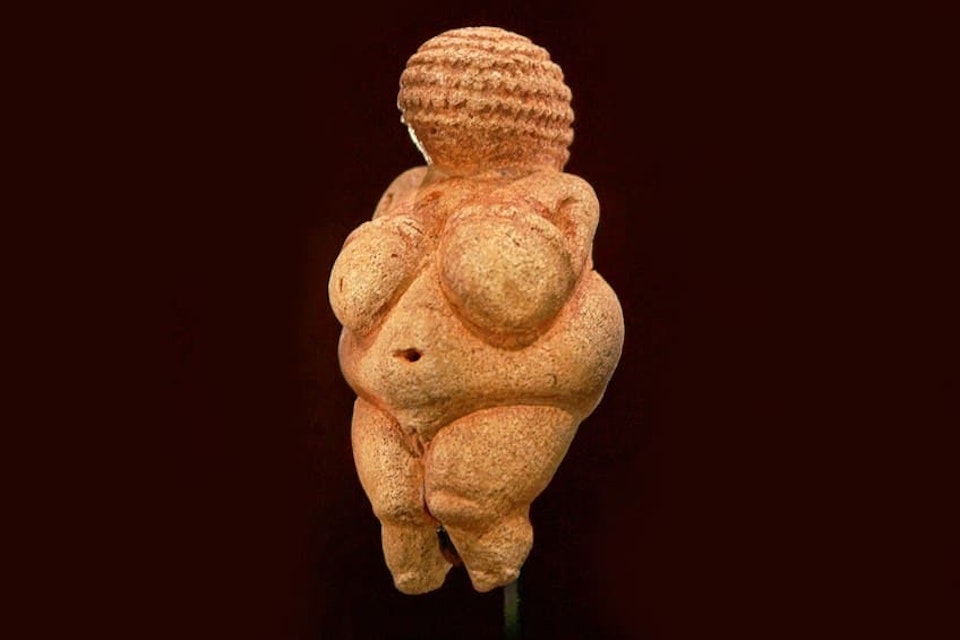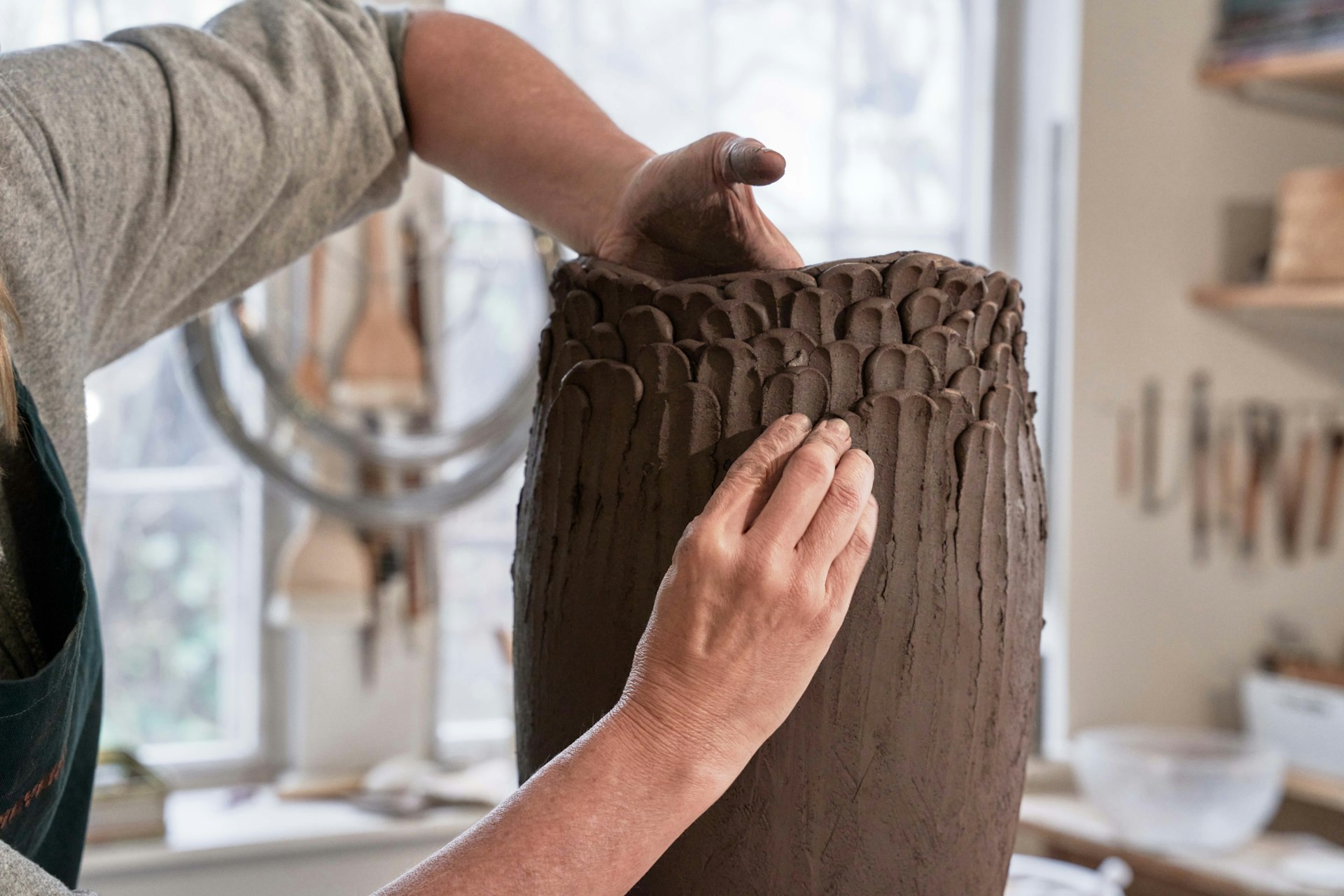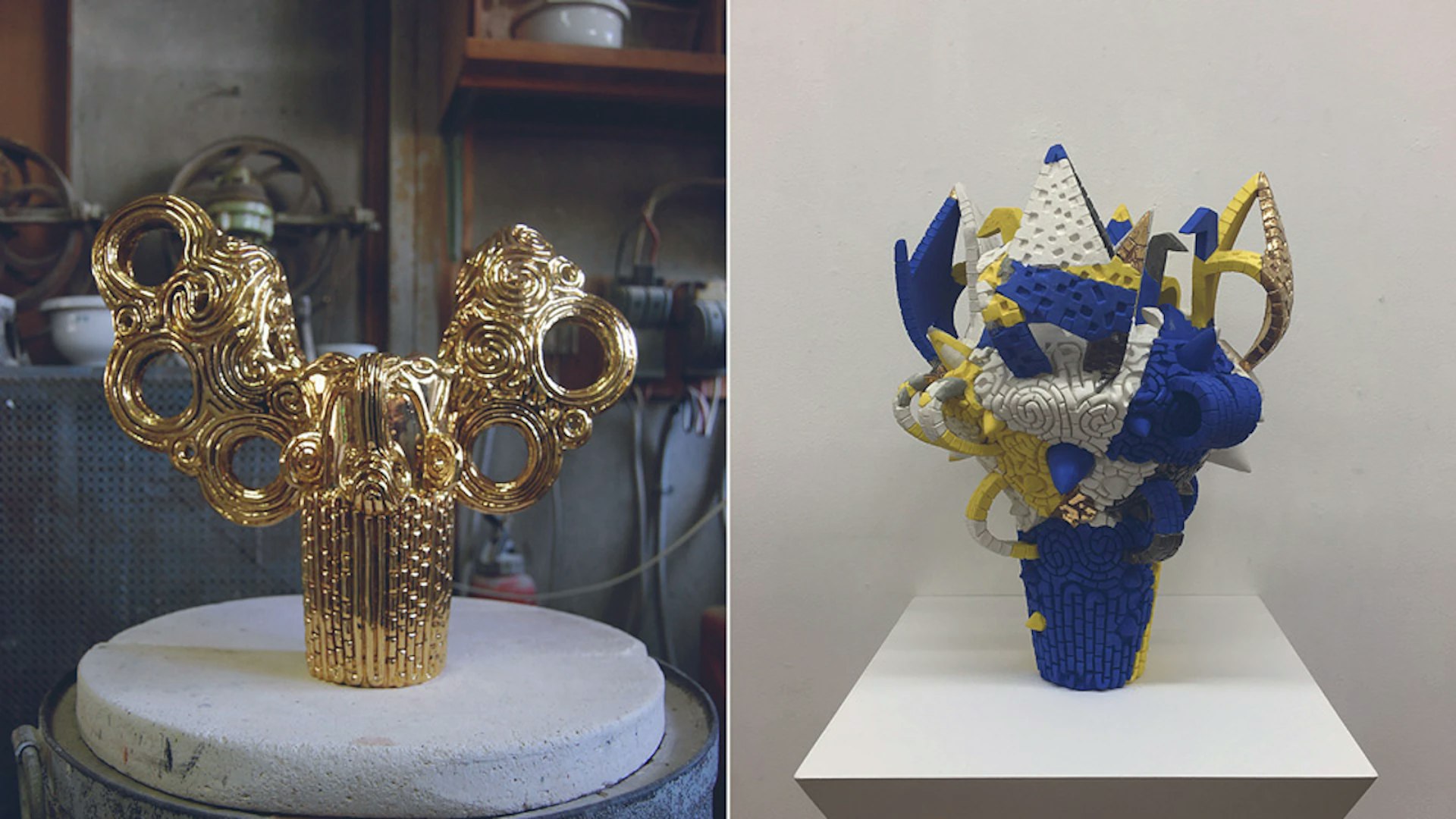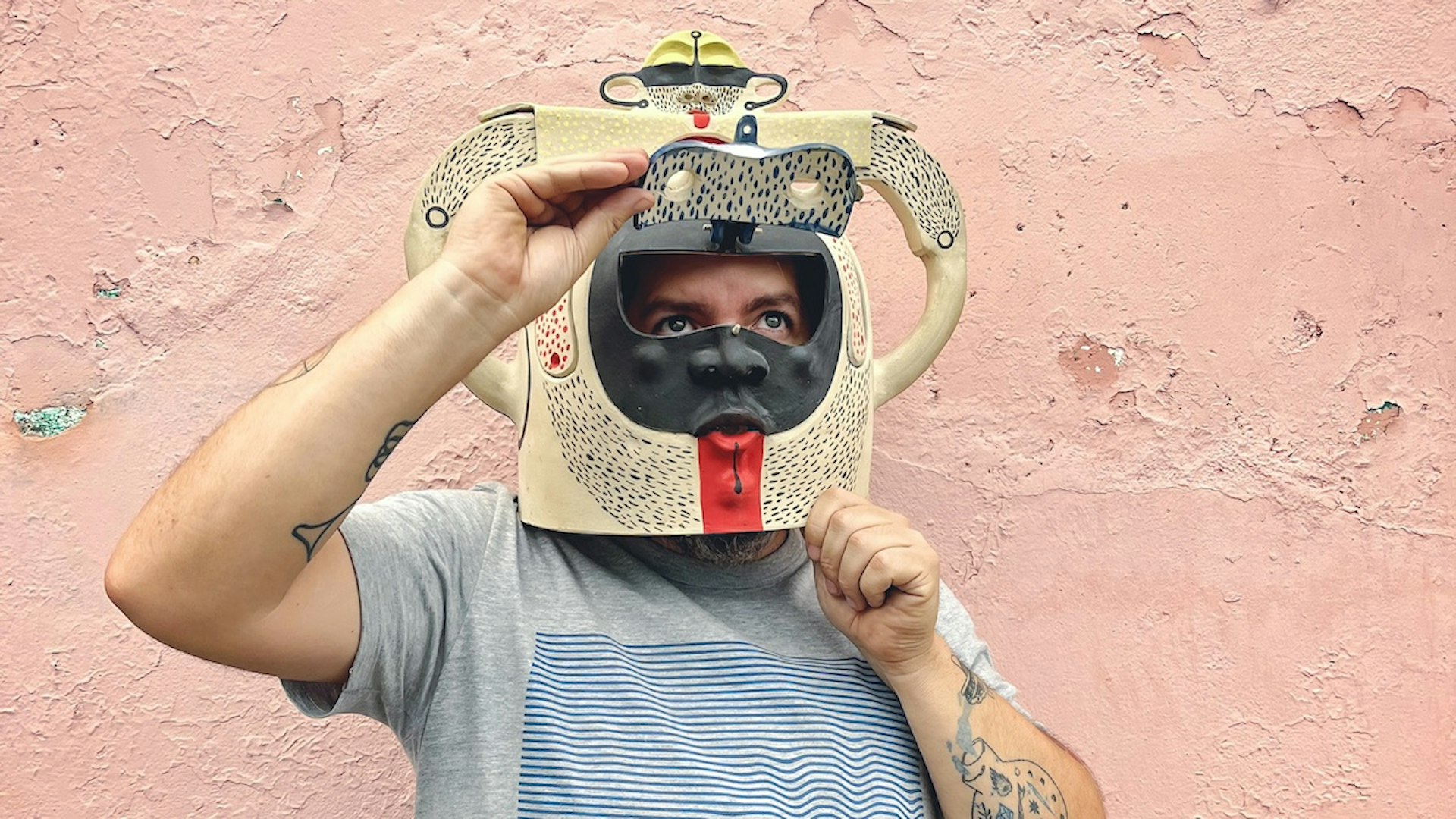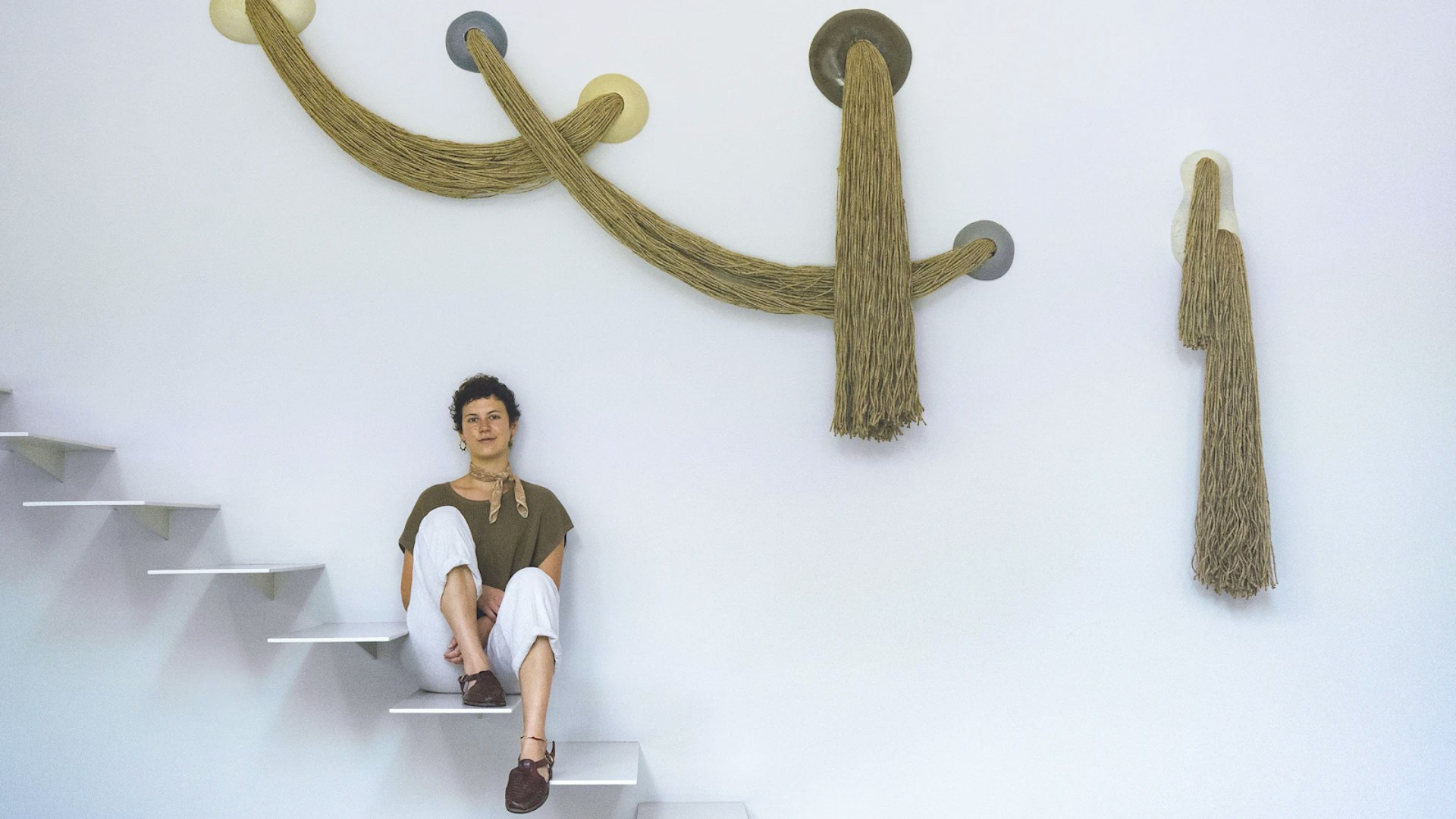March 18, 2024
Shaping the Future: Ceramics in a Contemporary World
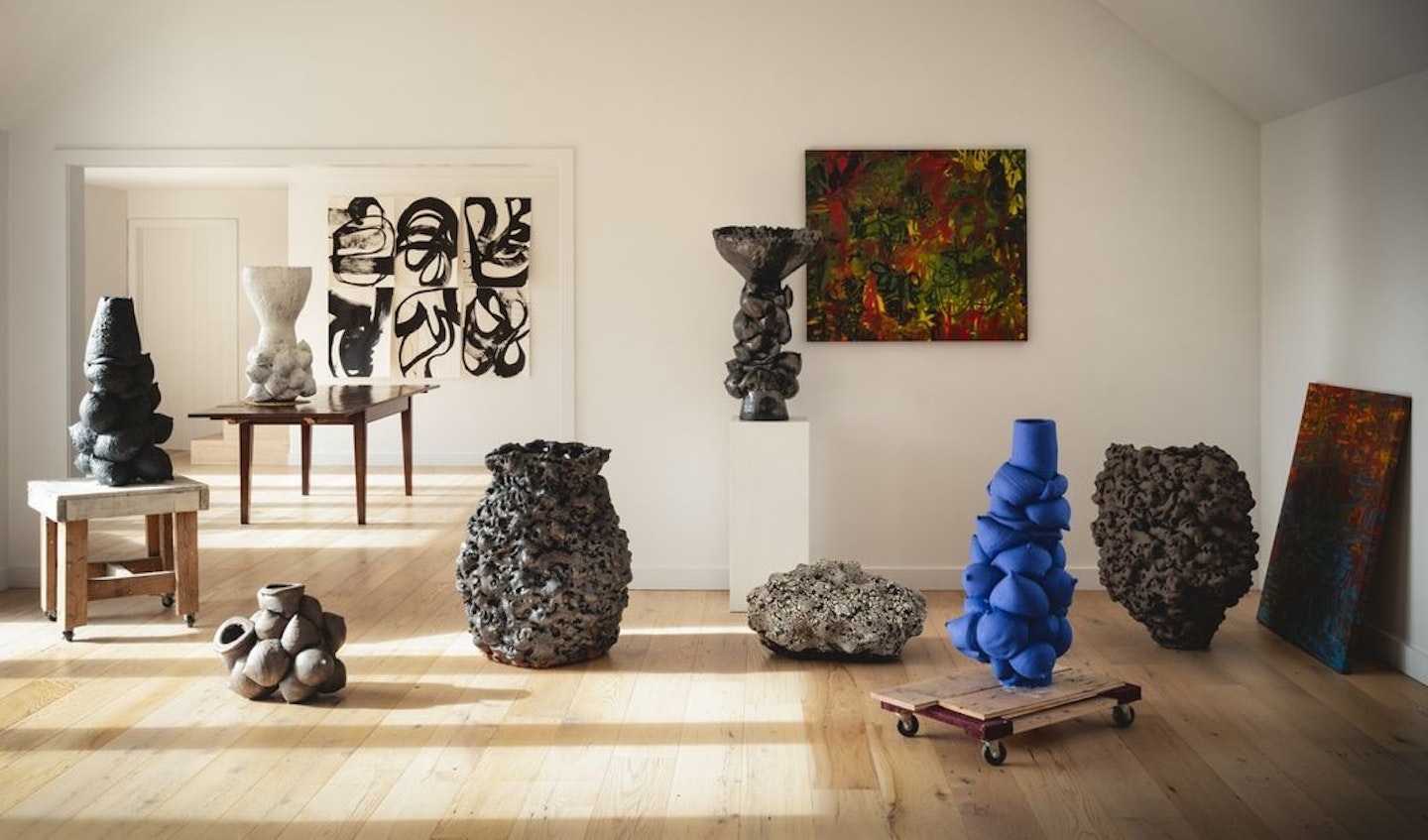
With their sometimes imaginative, sometimes functional works of art on display in galleries and museums around the world, ceramists are opening this ancient art form to everyone.
Take, for example, masterpieces from artists like Donna Green (Australian, b. 1960), now on view in New York at HB381 Gallery. Her “At Last, No More” exhibition is a new ceramic exhibition that tests our perceptions of clay. What can it do? What should it do? Experimenting with the limits of clay, Green's structures play with shape and space. Creating closed (and unconventionally textured) vessels, Green is one of many contemporary artists crossing the confines of traditional pottery.
On a global pedestal, clay is a spectacle. Re-emerging in a culture of screen-time and app-based art, ceramics have become a popular alternative. A way to use our hands again. Working with this tactical craft and succumbing to the unpredictability of wet clay, we have found ourselves yearning to slow down, reconnect, and reimagine possibilities.
So much so, we have to ask: Why is everyone so fired up about ceramics?
The Origins of Ceramics
Ceramics have stood the test of time, serving as a preservation of human existence for thousands of years. As one of the earliest forms of expression—dating back to the Paleolithic period— our discovery of clay's abilities sparked the emergence of a key industry. The earliest known ceramics pieces, found in southeastern central Europe, are the Gravettian figurines ( better known as the Venus figurines) that date back between 29,000 and 25,000 BCE. Found in cave dwellings across the European and Asian continents, these figurines were carved from mammoth bones. Heavily associated with fertility, the Venus models various depictions of the female form and gives us insight into the cultural practices of prehistoric society.
Venus of Willendorf (24,000-22,000 BCE), Natural History Museum in Vienna, Austria
Eventually, the invention of the wheel affected the aesthetic of ceramics made entirely by hand, allowing for smoother appearances thanks to clay techniques using wheel-throwing. By 9,000 BCE, ceramics became more utilitarian. Human ingenuity began to innovate with materials like bone ash and others that could melt and reform into glassy surfaces to correct the porous nature of early ceramics. Imagining practical uses for clay, ceramics then began to be used for transport, architecture, and storage.
A long cherished and fascinating artistic medium, the contemporary renaissance of ceramics is breaking new ground: challenging tradition and remembering life before mass production and tech.
VAWAA master artist and Copenhagen-based ceramist, Naja–best known for her abstract clay totems and magical, unrealistic sculptures.
Unplugging for Ceramic Closeness
The art of ceramics is a physical experience. As you mold your block, fresh muddy odors fill your airways. Kneading it like dough into shape, the damp clay stains your palms as it squishes between your fingers. You imagine the many lives this clay has lived. Where does it come from? Who dug it? How many hands have formed it? An appendage of your body and your expression, this clay is as human as you are.
Crafting with our hands requires presence. It is nearly impossible to focus your attention on anything else than the ball of clay in your hands. The first time I ever threw on a wheel, I was probably the most anxious I’d ever been. I had just finished my first year in graduate school. In a big city feeling so small, I was constantly looking for an escape where serenity could meet my creative passions. To my delight, I was surprised on my birthday with a seat at an introductory wheel-throwing class at BKLYN Clay. I remember feeling excited, but not being able to shake the anxieties of achieving perfection.
Then the instructor said: “You’re all beginners, just enjoy yourself.” I didn’t just enjoy—I had never felt more in sync. Focused and energized, perfectionism wasn’t a concern of mine for the first time in a year. I explored the medium completely. Laughing at my lopsided molds and melting forms. The imperfection of the entire experience felt so liberating—I created. I learned. I laughed.
That was almost 2 years ago, and still, I cherish the time when ceramics made me feel closer to myself than ever before; completely unrestrained by the worldly stressors that plagued me.
For many of us, the anxieties that come with modern life and a tech-dominated world have been eased by ceramics’ meditative nature. In a 2017 study, Hong Kong-based art psychotherapist Joshua K.M. Nan, and Rainbow T. H. Ho, a fellow professor at the University of Hong Kong, found that creating objects out of clay can help adults with depression to improve mood, decision-making, and motivation.
In the hands of a sculptor, a ball of clay becomes a vessel for expression—a conduit for emotions, and a canvas for the soul. As fingers mold and shape, the mind finds solace in the rhythmic dance between thought and action. With each gentle press, worries fade. There is an intimate dialogue between creator and creation, the chaos of the digital age silences and is replaced by the sanctuary of a creative flow. In the embrace of ceramics, we find respite from the relentless buzz and rediscover the simple joy of being present in the moment.
Works from VAWAA artist and Jōmon master potter, Junpei
For the Love of Clay
In realizing the restorative powers of ceramics, something awakens in our subconscious. Our creativity is untethered to boundaries, and we can marry a personal and modern anecdote to this human tradition.
Ceramists can create to their liking and gain a sense of mastery in the objects they've imagined. Whether you have taken a class at a local potter, or your work has been featured in an exhibition, you can absolutely claim the title of “ceramist”. The beauty of the art form is that there is no hierarchy in creation. We are all linked by our expressionist ideas for the love of clay.
VAWAA master artist Junpei is one of many in our vast artist community using the ancient tradition as a portal for the contemporary. Inspired by Japan’s oldest pottery styles Jōmon and Kintsugi tea cups—Junpei draws inspiration from human figures and an array of forms and patterns to create his works. In a delicate balance between form and function, Junpei is an honorary member of the contemporary class carving out a space for themselves.
Individuality is granted to the masses, but acceptance of new forms is seducing traditionalists away from their safeguards. Contemporary ceramics calls for new artists to explore the uncharted. No longer are we in the era of “untouchable” china in glass window cupboards. Today, we are pushing the boundaries of function and gaze.
The simple fact is: clay is an epilogue of human existence, and artists aren’t intimidated by the medium. As ceramics regains traction in unorthodox ways, we are witnessing experimentation with materials and techniques. From elegant porcelains to complex glazes, ceramics offer a breadth of imagination that dances with the obscure.
VAWAA artist Hernan, who works with his partner Natalia to make sound sculptures in clay, wearing one of their creations
Imagination is the main currency for artistic expression for sound sculpture artists Natalia and Hernan in Oaxaca, Mexico. Drawing inspiration from Andean heritage and the ancestral sound systems of early America, these VAWAA master artists are part of the global renaissance of ceramic exploration. Hernan, an Argentine musician, brings his 20 years of experience to Natalia’s historic passion for ceramics. Together they have pioneered methods for producing captivating sound through sculpture.
Vacation With An Artist's vast ensemble of forward-thinking ceramic artists (see all here) allows you to sculpt your own path. Expect to delve into the breadth of ceramic expression and lend yourself to the adventures of clay art.
If you prefer to honor tradition, VAWAA master potter Macrina in San Marcos Tlapazola will guide you through the Mexican red clay ceramics. The Zapotec village where she honed her craft for over 5 decades is internationally renowned. Working with indigenous red clay, Macrina has crafted beautiful bowls, plates, salseros, mezcal cups, comales, and flower vases.
A wise woman once told me, “Even tradition has its first day on the job.” Tradition can always alter to fit our desires, and that is exactly what VAWAA ceramist and textile artist Majo has proven time and again. Two hours west of Mexico City in the oasis of Valle de Bravo, Majo combines the techniques of ceramics, natural dyeing, and textiles to bring us back to joy—when life’s simplicities take center stage. Using macramé weaving in her sculptural pieces, the boundaries of clay are pushed, ushering us to remember that the world is our oyster on the throwing wheel.
VAWAA master ceramist and textile artist Majo in Valle de Bravo
While ceramics are historically imbued across the globe, their re-emergence with modern explorations is beyond alluring. It shows us that tradition can be molded to fit contemporary needs. It speaks to our innate human desire for connection: to the past, to the tangible world around us, and to the worlds we wish to see.
In ceramics’ simplicity lies a profound message: in embracing the timeless wisdom of the past, we can forge a new path, rooted in both tradition and the future. So let us continue to shape, mold, and sculpt—not just clay, but our own lives.
Written by Tyler Pharr
Explore all mini-apprenticeships, and be sure to come say hey on Instagram. For more stories, tips, and new artist updates, subscribe here.
